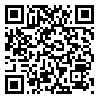Volume 15, Issue 6 And S7 (Artificial Intelligence- In Press 2025)
J Research Health 2025, 15(6 And S7): 3-3 |
Back to browse issues page
Download citation:
BibTeX | RIS | EndNote | Medlars | ProCite | Reference Manager | RefWorks
Send citation to:



BibTeX | RIS | EndNote | Medlars | ProCite | Reference Manager | RefWorks
Send citation to:
Khanbabaei H, Mohammadi S, Sadoughi H. Applications of Wavelet transforms in Radiomic Feature Extraction from Medical Images: A Systematic Review. J Research Health 2025; 15 (6) :3-3
URL: http://jrh.gmu.ac.ir/article-1-2807-en.html
URL: http://jrh.gmu.ac.ir/article-1-2807-en.html
1- Department of Radiologic Technology, Faculty of Allied Medicine, Kerman University of Medical Sciences, Kerman, Iran
2- Medical Physics and Radiology Department, Faculty of Paramedicine, Gonabad University of Medical Sciences, Gonabad,Iran
3- Medical Physics and Radiology Department, Faculty of Allied Medical Sciences, North Khorasan University of Medical Sciences, Bojnurd, Iran ,sadoughi.hamid@gmail.com
2- Medical Physics and Radiology Department, Faculty of Paramedicine, Gonabad University of Medical Sciences, Gonabad,Iran
3- Medical Physics and Radiology Department, Faculty of Allied Medical Sciences, North Khorasan University of Medical Sciences, Bojnurd, Iran ,
Abstract: (763 Views)
Backgroung: Radiomics relies on quantitative information extracted from medical images for improved clinical decision making, however it is subject to noise, artifacts and varying imaging protocols, all of which affect its reliability. Wavelet transforms provide a solution with which images can be decomposed into multiscale frequency components while retaining the spatial information. Comparing with classical preprocessing methods, this work highlights the necessity of an overall precondition framework for using wavelet transforms in radiomics.
Methods: In this study, we conducted a review by systematically searching databases such as PubMed, IEEE Xplore, Web of Science, and Scopus for peer-reviewed articles published between January 2015 and February 2025. We focused on keywords like “wavelet transform,” “radiomics,” “feature extraction,” and specific imaging modalities such as “CT,” “MRI,” and “PET.” We selected studies based on their relevance to wavelet-based radiomics and evaluated their quality using a modified QUADAS-2 tool.
Results: Our findings indicate that wavelet transforms can significantly enhance the reproducibility of radiomic features, minimize sensitivity to noise, and improve the detection of textural and morphological patterns in CT, MRI, and PET imaging. However, in certain situations, alternative methods like Empirical Mode Decomposition or Short-Time Fourier Transform may yield better results. Wavelet transforms often surpass traditional Fourier Transform techniques by offering localized and scale-dependent decomposition, even though they come with increased computational demands.
Conclusion: This review offers a thorough framework for wavelet-based radiomics, merging mathematical concepts with practical implementation strategies. It contributes to the field by providing clear approaches for optimizing parameters and extracting features, ultimately aiding researchers and clinicians in enhancing medical imaging analysis for precision medicine.
Methods: In this study, we conducted a review by systematically searching databases such as PubMed, IEEE Xplore, Web of Science, and Scopus for peer-reviewed articles published between January 2015 and February 2025. We focused on keywords like “wavelet transform,” “radiomics,” “feature extraction,” and specific imaging modalities such as “CT,” “MRI,” and “PET.” We selected studies based on their relevance to wavelet-based radiomics and evaluated their quality using a modified QUADAS-2 tool.
Results: Our findings indicate that wavelet transforms can significantly enhance the reproducibility of radiomic features, minimize sensitivity to noise, and improve the detection of textural and morphological patterns in CT, MRI, and PET imaging. However, in certain situations, alternative methods like Empirical Mode Decomposition or Short-Time Fourier Transform may yield better results. Wavelet transforms often surpass traditional Fourier Transform techniques by offering localized and scale-dependent decomposition, even though they come with increased computational demands.
Conclusion: This review offers a thorough framework for wavelet-based radiomics, merging mathematical concepts with practical implementation strategies. It contributes to the field by providing clear approaches for optimizing parameters and extracting features, ultimately aiding researchers and clinicians in enhancing medical imaging analysis for precision medicine.
Keywords: Wavelet Transform, Radiomics, Feature Extraction, Medical Imaging, Multiresolution Analysis
Type of Study: Review Article |
Subject:
● Artificial Intelligence
Received: 2025/05/18 | Accepted: 2025/10/28 | Published: 2025/10/28
Received: 2025/05/18 | Accepted: 2025/10/28 | Published: 2025/10/28
| Rights and permissions | |
 |
This work is licensed under a Creative Commons Attribution-NonCommercial 4.0 International License. |








